Thank you for visiting! By the way… any links on this page that lead to products on Amazon and other stores/partners are affiliate links Aquarium Store Depot earns a commission if you make a purchase.
Are you struggling with finding the best fish for 10 gallon tank?
In this blog, we share the fish you can fit in this aquarium size category, from schooling fish to inverts.
With over 25 years of experience in the aquarium hobby, I’ve assisted countless clients, hobbyists, and readers like you in setting up their dream aquarium. I’ve personally have kept many of these fish (with Bettas being my favorite) in real world setups to determine the best fish for 10 gallon tanks.
Top Picks
Let’s get straight to the point and go with my top picks. Bettas are my top choice because there are so many varieties available, and they have a great centerpiece look to them. White cloud minnows are the easiest to care for of all the fish I’m listing on this post. They don’t require a heater, school and are very hardy. Finally, pea puffers are a great choice if you want something unique, but they are semi-aggressive and best housed with their own kind in a species only tank in a group for an aquarium this small.
The 15 Best Fish For 10 Gallon Tank
Now that you know a little more about my top picks for fish you can keep in a 10-gallon tank, it’s time to meet some of the other fish! For you visual learners, my video is above for you to view. Check out my YouTube channel here.
For each species, I’ll be provided a quick rundown on the most important stats you need to know like:
- Their scientific name
- Size when fully grown
- Care Level
- Temperament
- What they eat
- Where do they come from
- Temperature range
- Swimming level in the tank
Let’s begin!
1. Betta
Use Coupon Code ASDFISH at Checkout
Betta Fish are one of the most beautiful varieties of freshwater fish available in the hobby. Easy to care for with plenty of varieties!
- Scientific Name: Betta splendens
- Adult Size: 2.5-3 inches
- Care Level: Moderate
- Temperament: Aggressive
- Diet: Carnivorous, Feed live/frozen foods, flakes, and pellets
- Origin: Vietnam, Cambodia, Thailand
- Water Temperature: 75-80°F
- Swimming Level: Top, Midwater
The betta fish is surely the most popular nano fish for freshwater tanks of all time! These aggressive little fish prefer to be kept as the only fish in the aquarium. They are also known as Siamese fighting fish because males will fight to the death if kept together in a small aquarium.
This means only a single male betta fish should be kept in a 10-gallon species-only tank. Don’t worry though, the tank won’t feel too empty because these colorful fish have plenty of personalities. Betta fish come in a huge range of colors and shapes, so there’s a type of betta out there to suit just about anyone. They do need warmer temperatures than most fish.
2. Guppy
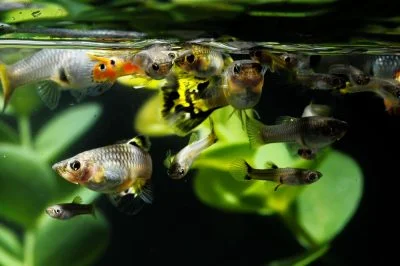
- Scientific Name: Poecilia reticulata
- Adult Size: 1-2.5 inches
- Care Level: Easy
- Temperament: Peaceful
- Diet: Omnivorous, feed dried, frozen, and live foods
- Origin: South America and the Caribbean
- Water Temperature: 63-82°F
- Swimming Level: All levels
Guppies are another one of the most popular fish in the aquarium hobby. These colorful, peaceful community fish come in an amazing variety of colors and breeds known as fancy guppies.
The fancy guppy is a hardy fish that does great in both community tanks and species-only tanks. They are livebearers, so if you would prefer not to breed them, make sure you don’t keep males and females in the same tank.
Female fish may already be pregnant when you buy them so males tend to be the better bet. The males are also smaller, more colorful, and have longer fins.
3. Rice
Japanese rice fish are a commonly overlooked fish suitable for freshwater aquascapes. Very peaceful and hardy fish that color up with companions
- Scientific Name: Oryzias Latipes
- Adult Size: 1-1.5 inches
- Care Level: Easy
- Temperament: Peaceful
- Diet: Omnivorous, feed dried, frozen, and live foods
- Origin: Japan
- Water Temperature: 72-80°F
- Swimming Level: All levels
Japanese Rice fish are an often overlooked, but extremely interesting and playful little fish. They have been raised for centuries in Asia due to their natural habitat being on rice patties across the continent! These curious creatures also go by many names including Medaka or Japanese killifish because they can be found naturally around these areas as well.
Ricefish, known for their peaceful nature, should be housed in the aquarium with other tranquil fish and larger invertebrates. Ricefish do best when kept at numbers of 6 or more, as they show their finest coloration and behavior when around others for companionship. They have the potential to jump out of a tank so you will want to cover your tank with an appropriate hood or glass lid.
4. Endler’s Livebearer

- Scientific Name: Poecilia wingei
- Adult Size: 1-1.8 inches
- Care Level: Easy
- Temperament: Peaceful
- Diet: Omnivorous, feed dried, frozen, and live foods
- Origin: Venezuela, South America
- Water Temperature: 72-80°F
- Swimming Level: All levels
Endler’s livebearers are the nano cousin of the common guppy. Like guppies and mollies, these fish breed very easily in the home aquarium. You can prevent breeding by keeping only specimens of a single-sex.
Males are smaller and more colorful than females, just like guppies. These colorful little fish are very easy to care for and great fun to watch as they forage all over the tank. This is one nano fish that I would recommend to any beginner!
5. Chili Rasbora
- Scientific Name: Boraras brigittae
- Adult Size: 0.8 inches
- Care Level: Easy
- Temperament: Peaceful
- Diet: Carnivorous, feed-dried, frozen, and live foods
- Origin: Southeast Asia
- Water Temperature: 68-82°F
- Swimming Level: Top, Midwater
The Chili rasbora (video source) is a tiny fish that does great in a 10-gallon aquarium. They can be kept on their own or with other community fish and inverts.
These bright orange fish captivate aquarists with interesting black markings on their sides and fins. Chili rasboras are schooling fish and you can keep as many as 20 of them in a planted 10-gallon tank with great filtration.
6. White Cloud Minnow
A very peaceful fish that does well in coldwater fish. Other minnow varieties are also available
- Scientific Name: Tanichthys albonubes
- Adult Size: 1.5 inches
- Care Level: Easy
- Temperament: Peaceful
- Diet: Carnivorous, feed-dried, frozen, and live foods
- Origin: China
- Water Temperature: 58-72°F
- Swimming Level: Midwater
White cloud mountain minnows are beautiful and graceful schooling fish that are a great choice for a 10-gallon aquarium. They are not tropical fish like the other species in this list and are suitable for cool water tanks.
White cloud minnows are available in some amazing varieties, with gold body color, or long flowing fins for example.
7. Celestial Pearl Danio
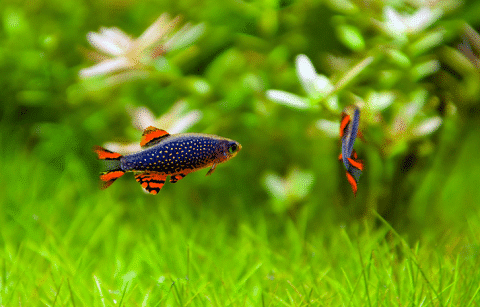
- Scientific Name: Celestichthys margaritatus
- Adult Size: 0.75 inches
- Care Level: Moderate
- Temperament: Peaceful
- Diet: Omnivorous, feed dried, frozen, and live foods
- Origin: Thailand, Myanmar
- Water Temperature: 68-78°F
- Swimming Level: Midwater
The celestial pearl danio is beautiful nano fish that is a wonderful choice for a 10-gallon aquarium. These small fish are most happy in a heavily planted tank. They can be kept with other peaceful fish, but they can be outcomhttps://aquariumstoredepot.com/blogs/news/small-freshwater-fishpeted by faster more aggressive feeders and bigger fish.
Celestial pearl danios are small school fish, so be sure to pick up a group of at least 6 individuals.
8. Neon Tetra
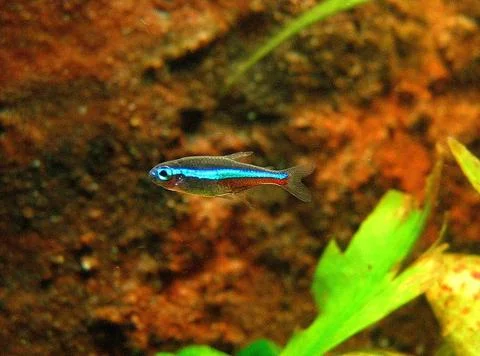
- Scientific Name: Paracheirodon innesi
- Adult Size: 1 inch
- Care Level: Easy
- Temperament: Peaceful
- Diet: Omnivorous, feed dried, frozen, and live foods
- Origin: South America
- Water Temperature:70-77°F
- Swimming Level: Midwater
The neon tetra is a classic nano fish that will add amazing color to your 10-gallon tank.
This is about the smallest tank size that neon tetras will thrive in, but with great filtration, you can easily keep small groups of 6 to 8. These popular tropical fish are easy to find at just about any pet store and are very easy to care for.
9. Female Bettas
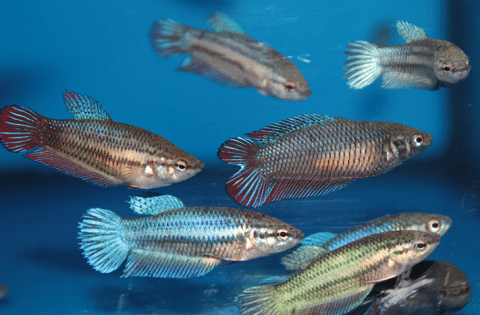
- Scientific Name: Betta splendens
- Adult Size: 2-2.5 inches
- Care Level: Moderate
- Temperament: Semi-aggressive
- Diet: Carnivorous, Feed live/frozen foods, flakes, and pellets
- Origin: Vietnam, Cambodia, Thailand
- Water Temperature: 75-80°F
- Swimming Level: Top, Midwater
Female betta fish are often overlooked in the aquarium hobby because they don’t have as much color and fancy finnage as the males. The truth is that females still have great colors and personalities. They are not as aggressive as the males, which makes them a better option as tank mates for community tanks. You will have an easier time finding tank mates with females.
A small group of female betta fish is known as a sorority. Experienced aquarists can keep a sorority in a 10-gallon tank, but a single female betta is usually the perfect fish for a tank of this size.
10. Zebra Danio

- Scientific Name: Brachydanio rerio
- Adult Size: 1.5-2 inches
- Care Level: Easy
- Temperament: Peaceful
- Diet: Carnivorous, feed dried, frozen, and live foods
- Origin: India
- Water Temperature: 70-82°F
- Swimming Level: Top, Midwater
Zebra danios are very adaptable and hardy fish that can be housed in a 10-gallon aquarium. These active fish are great fun to watch as they zoom around the tank at high speed!
Zebra danios are not always schooling fish, but a group of at least 5 or 6 danios should be kept in the same tank. These fish need plenty of swimming space, so make sure you leave a lot of space available.
11. Dwarf Corydoras Catfish
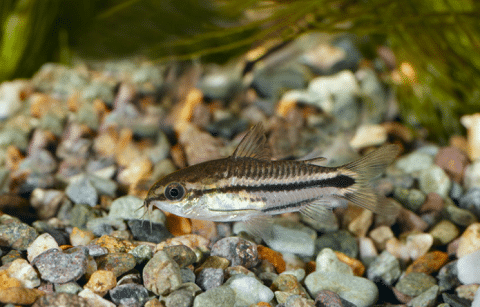
- Scientific Name: Corydoras hastatus
- Adult Size: 1 inch
- Care Level: Moderate
- Temperament: Peaceful
- Diet: Omnivorous, feed dried, frozen, and live foods
- Origin: South America
- Water Temperature: 72-78°F
- Swimming Level: Midwater
The dwarf corydoras is a great little cory catfish that stays really small. These schooling catfish swim around actively in the midwater of the aquarium, unlike most other species of cory cats that are bottom dwellers.
10 gallons is the minimum tank size that these cory catfish should be kept in and they do best in groups of at least 6. They are a great addition to community tanks with other community fish.
12. Freshwater Pea Puffer
At only an inch in length, this is the smallest pufferfish you can purchase in the aquarium hobby
- Scientific Name: Carinotetradon travancoricus
- Adult Size: 1 inch
- Care Level: Moderate
- Temperament: Aggressive
- Diet: Carnivorous, feed frozen and live foods
- Origin: India
- Water Temperature: 72-82°F
- Swimming Level: Top, Midwater
The freshwater pea puffer (video source) is a unique tropical fish species that has a larger-than-life personality. These tiny predators are aggressive fish that do best in a species-only tank.
I would suggest keeping just one freshwater pea puffer in a 10-gallon tank. Some aquarists have had success keeping as many as 3 of these fascinating fish in this tank size, however.
If you do plan on keeping more than one, make sure your tank is heavily planted. Adding plenty of structure like driftwood will also ensure that the fish are not constantly visible to one another. It can be difficult to house them with other fish successfully.
13. Dwarf Gourami

- Scientific Name: Trichogaster lalius
- Adult Size: 2.5-3 inches
- Care Level: Moderate
- Temperament: Semi-aggressive
- Diet: Omnivorous, feed dried and frozen foods
- Origin: India, Bangladesh, Pakistan
- Water Temperature: 72-82°F
- Swimming Level: Top, Midwater
The dwarf gourami is an amazing little fish from the same family as the betta fish. They are the smallest gourami type and therefore the best option for small tanks.
Due to their small size, a pair of these beautiful fish could be kept in a 10-gallon aquarium, as long as you have great filtration and plenty of live plants and hiding places. Dwarf gourami fish like dark, shady spots in the tank, and this will allow the female to get some alone time if the male is giving her too much attention.
14. Freshwater Shrimp
Freshwater aquarium shrimp are a great addition to small tanks and aquascapes. Peaceful, full of personality, and colorful. Many varieties are available.
- Scientific Name: Neocaridina davidi
- Adult Size: 1-1.25 inches
- Care Level: Easy
- Temperament: Peaceful
- Diet: Omnivorous, Algae
- Origin: Taiwan
- Water Temperature: 60-82°F
- Swimming Level: Bottom
You don’t have to keep fish species to have a lively 10-gallon aquarium. Freshwater shrimp are another cool stocking option for nano aquariums. These useful inverts eat algae and leftover food from the bottom of the tank. There are many types of freshwater shrimp and great algae eaters available with the cherry shrimp being the one with the most utility in an aquarium.
These cherry shrimp are relatively hardy and can be found in a great variety of different color morphs from cherry-red to deep blue. Baby are not safe with any fish species in the tank, but adults can be kept with some nano fish like dwarf corydoras.
15. Nerite Snails
Nerite snails are one of the best algae eating snails you can buy. Plant safe and do not reproduce in fresh water!
- Scientific Name: Clithon, Vittina, and Neritina spp.
- Adult Size: 1-1.5 inches
- Care Level: Easy
- Temperament: Peaceful
- Diet: Algae
- Origin: Africa and Asia
- Water Temperature: 72-82°F
- Swimming Level: Bottom
Many fishkeepers think of snails as unwanted pests. They’ve probably never kept nerite snails! These awesome algae eaters cannot breed in freshwater which means they never take over tanks.
What’s more, they are great-looking animals and add very little bioload to a small tank. There are few species of nerites in the aquarium hobby, including the horned, tiger, zebra, and olive nerite snail. All of them are ideal for 10-gallon aquariums.
What You Need to Know About Stocking For Your Aquarium
The first thing to know when stocking a ten-gallon aquarium is that smaller doesn’t necessarily mean easier. The smaller the aquarium is, the less stable the water conditions will be.
There is just something so special about a nano aquarium, however, that makes the challenge welcome. For me, there are 3 keys to success when keeping a 10-gallon fish tank:
- Choosing the right fish
- Providing good quality filtration
- Keeping up with regular maintenance
I’ll cover each of these factors in the article, so make sure you read until the end.
Debunking the Inch-Per-Gallon Myth
How many fish can comfortably inhabit a 10-gallon tank? Many fish keepers will automatically go to the inch-per-gallon rule when stocking an aquarium. This old rule states that you can keep 1 inch of fish for every gallon of water in your tank.
In many cases, this can be good advice, but there are always exceptions to any rule! For example, ten 1-inch-long fish might sound just fine for a 10-gallon tank, but one 10-inch fish will obviously be too big for the same fish tank.
Of course, you can keep more fish of a small species in a tank than the same number of larger fish. It is equally important to understand that not all fish have the same needs.
Keeping too many fish in your tank creates a few different problems. The obvious issue is that the fish will feel cramped and not be able to behave naturally. Poor water quality problems are just as serious, if not more so!
The more fish you have in a tank, the more waste they are going to produce. This waste can cause big problems if not managed, and the results can be tragic for your pets. Beefing up your filtration and maintenance, and growing plenty of live plants can increase the number of fish you can keep, but there are definitely limits.
Aquariums Hold Less Water Than You’d Think
Another important thing to remember is that a ten-gallon aquarium usually doesn’t hold a full 10 gallons of water. Your aquarium is never completely full either because you’ll want to leave just a little room to prevent spilling during feeding and maintenance.
Along with the water, your aquarium will probably contain:
- 1-3 inches of substrate
- Hardware like the heater, filter, thermometer, etc.
- Hardscape features like rocks and driftwood
- Ornaments and decorations
As you can tell, your ten-gallon tank will not be able to house 10 inches of fish if you follow the inch-per-gallon rule. In fact, you’d need to bump the number down to about 8 inches.
The Characteristics of the Ideal Nano
In the aquarium hobby, very small fish are generally known as nano fish. But what makes a good nano fish? The following factors are all important characteristics:
Size
Of course, a fish for small aquariums should not outgrow its tank. This is one of the biggest mistakes beginners make when choosing new fish at the pet store.
90% of the fish you see in their tanks are juveniles, and have a whole lot of growing to do! Always make sure to research the adult size of a fish before taking it home.
Hardiness
The tank environment can be a lot less stable than the natural habitat of freshwater fish. This is especially true in small tanks like 10 gallons. The easiest nano fish are the hardy species that can survive fluctuations in water parameters and conditions.
Behavior
Size and hardiness are extremely important characteristics, but understanding the natural behavior of a fish species is just as crucial. Aggressive, territorial fish like male bettas can do great in small aquariums, but only if they are the only member of their species in the tank!
Other awesome nano species like the freshwater pea puffer are less particular about who they’ll attack and they should only be kept with their own species, or on their own in smaller tanks.
Finally, the ideal nano fish does not require too much swimming space, because there isn’t much room in a nano aquarium.
How To Set Up the Aquarium
After you’ve chosen the kind of fish you want to keep, the next step is to learn how to provide them with the perfect home.
A great place to start is to look at the natural habitat of the fish you keep, whether you’re setting up a community tank or keeping just one fish species. In this section, I’ll give you a quick rundown of what you’ll need.
Filtration
An aquarium filter is a must-have for any 10-gallon tank. The only question is, which type of filter should you get? There are many different types of aquarium filters available on the market today, and you will need to select a model that suits your tank size, fish type, and budget.
For the ultimate display tank, I suggest a small canister filter. These filters create a much more natural look by taking up no room in the tank (apart from the intake and outflow pipes, of course). Hang-on back and internal power filters are also great options, and even the humble sponge filter will provide great filtration, at a very reasonable price.
Whichever type of filter you choose to run, make sure it is rated to at least 10 gallons. You can certainly use a filter designed for larger tanks too, the only consideration is that you do not want to blast your fish with an overly strong water flow!
Heating
Most of the aquarium fish and inverts in the hobby are tropical species, which means they are at home in warm temperatures. If you live in a tropical part of the world, you might be able to get away with an unheated tank.
Using an aquarium heater is usually the best option no matter where you live, however, because it maintains stable temperatures. A small aquarium thermometer mounted somewhere in the tank is also very handy for monitoring the performance of the heaters in your fish tanks.
Lighting
Your choice of lighting is very broad unless you are going to be growing live plants. Even then, standard LED or fluorescent lighting will usually work just fine for low-light species like Java ferns. For plants that require moderate to high light, you’re going to need some good quality lights in the correct spectrum for live plants.
Current USA's offering into aquascaping is an incredible value. Spectrum, spread, easy to program and great PAR output.
I recommend running your lights for 6-10 hours a day to provide your fish with a natural photoperiod. Setting your lights on a timer is the best way to keep the timing consistent.
Maintenance
Having a fully cycled aquarium with all the equipment and the perfect nano fish for your ten-gallon setup is not the only thing you need to maintain an awesome fish tank. You’ll also need to roll up your sleeves on a regular basis to keep your tank clean and your fish happy.
Read on for a brief introduction to tank maintenance.
Water Quality
Water quality decreases over time as fish waste and uneaten food accumulate in the tank. Although your filter will go a long way towards maintaining good water quality, there’s no way to get around performing regular partial water changes.
This is so important because nitrates will eventually build up to high enough levels to poison your pets. Physical waste will also accumulate on the substrate and hardscape in your tank, which doesn’t look so great.
Testing
A basic test kit is an absolute must-have for any aquarist. They are vital for testing to determine your pH, hardness, and other parameters, and to determine when your tank is cycled.
You’ll also need to test your nitrate levels regularly to work out the ideal frequency and volume of water changes necessary for your setup.
Keeping Your Aquarium Clean
The best time to clean up your aquarium is while you are performing water changes. Since you will be siphoning water out of your tank, you may as well suck up all the waste on the substrate and hardscape with your gravel vacuum at the same time!
Algae can be removed from the glass and hardscape with an algae scraper and a small brush. You will also need to rinse out your filter media from time to time.
This should only be done with conditioned water or old water that you have taken out during a water change. This will keep your hard-working beneficial bacteria safe from the harmful chemicals in tap water.
Growing Plants
Growing live plants in your aquarium has a number of great benefits. In case you aren’t already convinced, here are 5 reasons to grow live plants in your ten-gallon aquarium:
- Live plants provide your fish with a more natural habitat
- Micro-organisms that grow on live plants are a great food source for small fish
- Live plants oxygenate the water
- Plants use nitrates as a fertilizer
- Growing live plants is fun!
Live plants do best with good lighting. Choose a light that is specifically designed for aquarium plants for the best growth. Once you’re a little more experienced, you may want to invest in a CO2 injection system for a densely planted tank with the most beautiful plants.
Creating a ten-gallon aquascaped aquarium with amazing nano fish is a challenging but hugely rewarding goal for any aquarist!
Where To Buy The Aquarium
Most of the species in this list can be found at your local fish store. Trusted online fish dealers are another great place to find nano fish. Buying online also takes a lot of the hassle and stress out of transporting sensitive fish for longer distances.
FAQs
What fishes can the aquarium hold?
Unfortunately, most aquarium fish are simply too large or need too much space to be kept in a 10-gallon aquarium. All the fish species in this list are great starting points for stocking a 10-gallon tank.
What is the biggest type you can keep in this size aquarium?
An adult male betta is probably the largest fish that can be kept comfortably in a 10-gallon tank.
Can I have 8 fishes in this aquarium?
You can definitely keep 8 fish in a 10-gallon tank. However, it’s important to avoid overstocking. The species of fish is very important, however. Nano-schooling fishing like ember tetras and chili rasboras, for example, are excellent fish choices for this tank size.
How many can I have in this size of the aquarium?
The number of fish you can keep depends on all kinds of different factors. Most fish species cannot be kept in a 10-gallon tank, but some species will even do fine in groups of as many as 20 or more.
Final Thoughts
A 10-gallon tank freshwater aquarium is a great size for your bedroom or even your desk at the office. Now that you’ve been introduced to different species of nano fish and inverts, which species will you choose?
Let us know below, we’d love to hear from you! If you are looking for fish for a 20 gallon tank, check out this article.
- About the Author
- Latest Posts
I’m thrilled that you found Aquarium Store Depot! Here you’ll find information on fish, aquariums, and all things aquatics related. I’m a hobbyist (being doing this since I was 11) and here to help other hobbyists thrive with their aquariums! I adhere to a high quality Editorial Process and Review products with real life field usage and practical analysis.

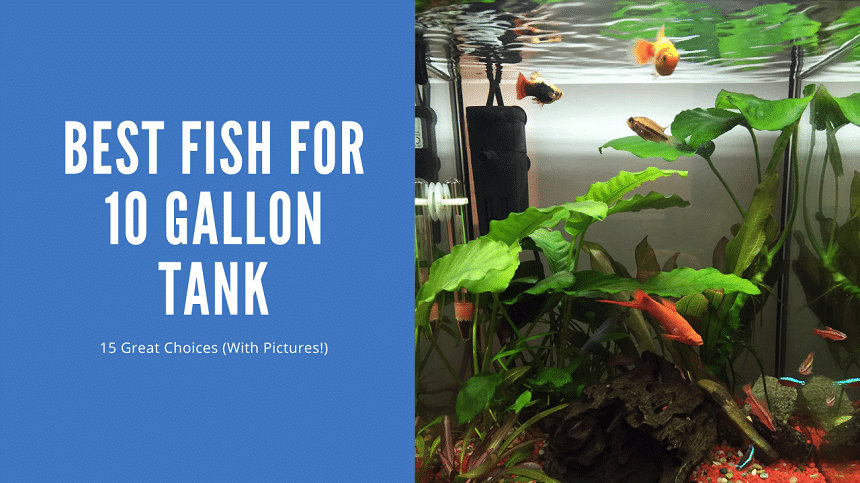
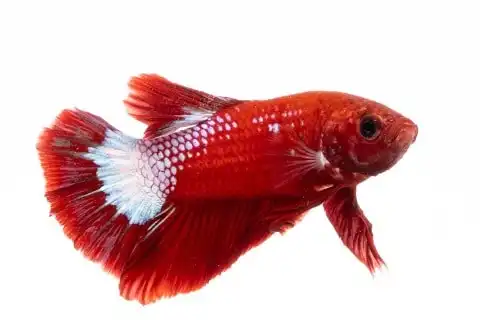



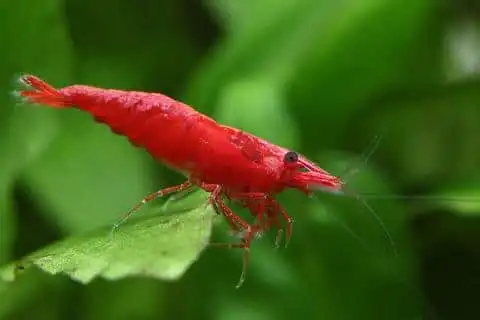
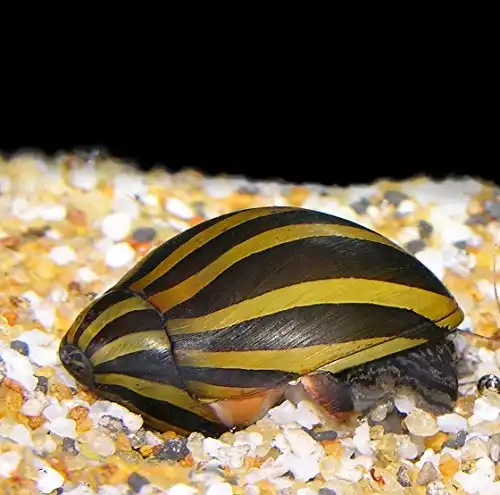





Hi, would it be possible to add 1 snail, 4 Celestial Pearl Danio and 3-5 guppys in a 10 gallon tank? I really love mixtures of small fish and hope that i would be able to put all my favorites in 1 tank comfortably and peacefully.
It’s possible with enough filtration
Hi there, first of all, fantastic article, second of all, in your expert opinion, what if I was considering housing a pair of fathead minnows, a single male or female Betta, and four pygmy cories, in a planted tank in which I have created some “caves” among the decorations. Doable or not?
These are all generally compatible granted you have a large enough tank. Is this for a 10 gallon size? It’s possible with the right amount of filtration.
Are there suggestions for creating combinations of nano fish for a 10 gallon tank? For example, is there a suggested combination for 2 species of 6 fish each or for 3 species of 4 fish each? Can you list some specifics for possible combinations by species and numbers when stocking a 10 gallon tank as a community tank?
Hi There. You can pull off a school of 5 fish and another group of 4-5 fish with proper filtration. You’ll want to mix water level species — for example chili rasboras with dwarf cory catfish
Perfect! Thank you for the response and for all the good info on your site!
Hi Mark, I really like this site. But I did have very good success with smaller non schooling fish in my community tank. But I am definitely looking forward to learning more about aquariums from your site. Thanks for posting this.
I love the 10 best fish but I have also had great success with other fish for my 10 gallon community tank that are not schooling fish although neon tetras are my #1 favorite choice. I am definitely going to follow this site and look forward to learn more. Thanks for posting this